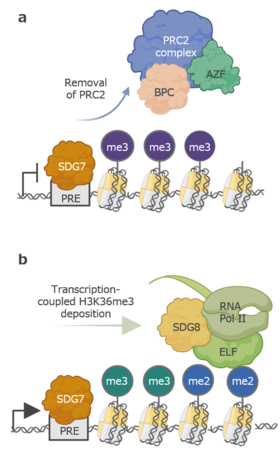Biological Science 2024/09/12
NAIST researchers shed light on the intricate roles of various proteins involved in regulating genetic expression in flowering plants
One of the most fascinating discoveries in biology is that cells have mechanisms for dynamically regulating genetic expression. This ability to promote or restrict the transcription of specific genes without altering the DNA sequences themselves is essential to all forms of life, from single-cell organisms to the most complex plants and animal species.
While our understanding of these so-called epigenetic mechanisms is far from complete, remarkable progress has been made in this field with the understanding of the role of the Polycomb Repressive Complex 2 (PRC2). PRC2 is a protein that, in many plants, binds to specific DNA sequences called polycomb response elements (PREs) and applies a chemical mark to nearby histones (the structural support of DNA in the nucleus). Known as "trimethylation of H3K27 (H3K27me3)," this chemical modification prevents nearby genes from being converted into RNA and, in turn, into proteins, effectively silencing them. Despite this knowledge, however, scientists haven't yet understood how genes silenced by PRC2 can be turned back on.
In a recent study published in eLife, a research team from Nara Institute of Science and Technology (NAIST) in Japan sought to find answers to this puzzle. Led by Nobutoshi Yamaguchi, the team conducted extensive experiments on genetically modified Arabidopsis thaliana plants, revealing key parts of the complex epigenetic orchestra that goes on within these and many other organisms.
The researchers mostly focused on Set Domain-containing Protein 7 (SDG7), which is known to regulate the methylation of proteins in the cell cytosol (intracellular fluid). Preliminary experiments revealed that SDG7 is also present in the cell nucleus, which prompted the team to investigate further.
After an extensive series of analyses and measurements on mutant A. Thaliana cultures, the researchers uncovered a new role for SDG7. It turns out this protein also binds to PREs, competing with PRC2. Moreover, SDG7 can actually displace PRC2, preventing it from leaving the H3K27me3 mark. On top of this, SDG7 adds an active histone mark itself via the methylation of H3K36. After H3K36 methylation is in place, the protein pair SDG8 and Polymerase Associated Factor 1 (PAF1) spread this active mark across the gene's body, resulting in efficient gene activation.
In a way, the histone sites H3K27 and H3K36 can be interpreted as a "switch" that can dynamically turn on and turn off the expression of specific genes. "This simple and elegant antagonistic molecular switch between H3K27 and H3K36 methylation is ideally suited for epigenetic reprogramming during plant development," highlights Yamaguchi. "Since switching between H3K27 and H3K36 methylation has been seen in many flowering plants, the competitive mechanism between SDGs and PRC2 at PREs may be conserved across many plant species during for controlling development."
This study sheds light on the intricate epigenetic mechanisms that countless species of plants and animals may rely on, potentially paving the way for future breakthroughs in the agricultural, horticultural, and farming fields. "We believe our findings will be of broad general interest to plant biologists and epigeneticists, given the widespread role of epigenetic regulation in gene expression during development and environmental responses," concludes Yamaguchi.
###
Resource
- Title: Arabidopsis SDG proteins mediate Polycomb removal and transcription-coupled H3K36 methylation for gene activation
- Authors: Yicong Wang, Masato Abe, Yuka Kadoya, Takeru Saiki, Kanae Imai, Xuejing Wang, Taiko Kim To, Soichi Inagaki, Takamasa Suzuki, Tetsuji Kakutani, Toshiro Ito, Nobutoshi Yamaguchi
- Journal: eLife
- DOI: https://doi.org/10.7554/eLife.100905.1
- Information about the Plant Stem Cell Regulation and Floral Patterning Laboratory can be found at the following website: https://bsw3.naist.jp/eng/courses/courses112.html






